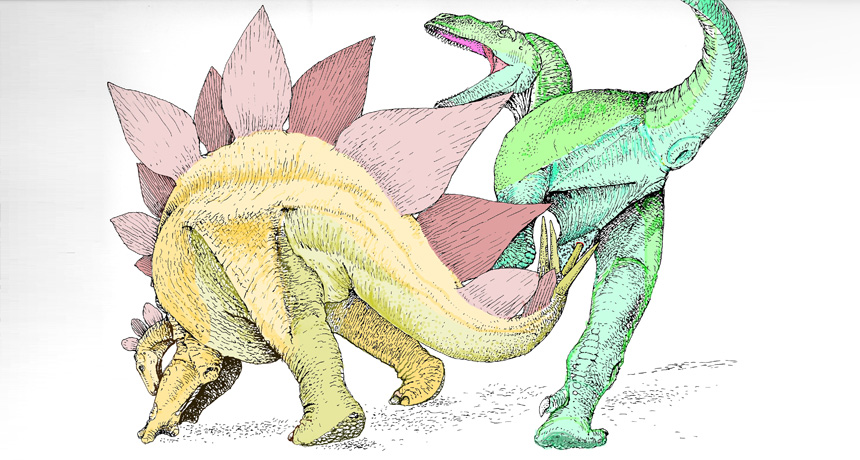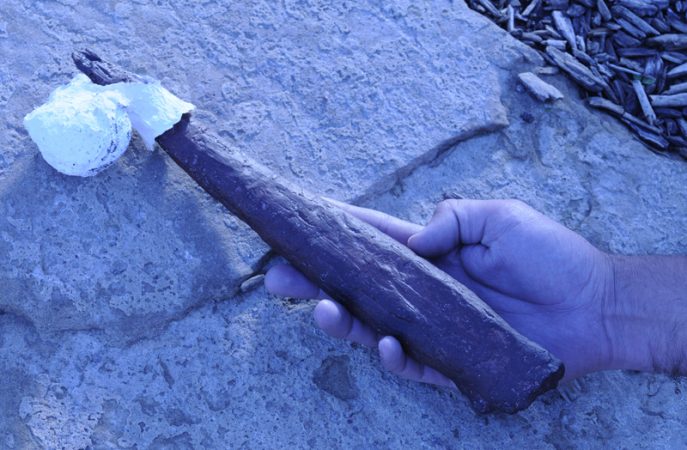Spiked tail to the rescue!
Fossils of an ancient predator offer clear evidence that plant-eating stegosaurs weren’t defenseless

Ouch! Artist’s drawing suggests how the stegosaur defended itself from an attacking allosaur. It jabbed a large tail spike into the private parts of the hungry, 3-ton predator.
Robert Bakker
By Sid Perkins
About 145 million years ago, a large and hungry meat-eating dinosaur was prowling for dinner in what is now Wyoming. Suddenly, the allosaur pounced. To his likely surprise, the fierce, multi-ton predator didn’t catch a nice meal. Instead, it got a swift poke in its privates from its spike-tailed prey — a lumbering, plant-eating stegosaur. One of those spikes pierced a bone in the allosaur. The wound resulted in a painful infection. Several days or weeks later, the allosaur died.
That’s the tale told by the allosaur’s infected bone. It was preserved as a fossil. By probing these remains, scientists have learned several things about the dinosaur and its prey. (Maybe the most important: Don’t mess with a stegosaur!)
At about 9 meters (30 feet) long and weighing probably 3 metric tons (6,600 pounds), the unlucky allosaur was a biggie. It probably weighed about the same as the stegosaur, notes Robert Bakker of the Houston Museum of Natural Science in Texas. As a vertebrate paleontologist, he studies the fossil remains of animals with backbones. Allosaurs were among the top predators of their era. But great size and fearsome teeth could not shield it from bacteria, Bakker notes.
The allosaur fossils that his team probed included a solid, L-shaped bone. It was located in the dinosaur’s pelvic area. The bone was about as thick as an adult human’s forearm.

The bone was damaged; it had a cone-shaped hole. The hole passed right through the bone. On the underside, where the stegosaur spike entered, the bone’s wound is circular. On the top side, closest to the allosaur’s internal organs, there’s a smaller hole — and a baseball-sized cavity, Bakker notes. That cavity marks where the impaled bone was later dissolved by an infection.
The damaged bone shows no signs of healing. So it’s a safe bet that the allosaur died from that infection a week to a month after the attack, Bakker says. He described the fossils on October 21 at a meeting of the Geological Society of America, in Vancouver, Canada.
Adult stegosaurs were about the size of today’s rhinos, observes Bakker. And their tails were unusual in many ways. The most obvious features are the large, cone-shaped spikes at the end of the tail. These bony spikes would have been covered with a material called keratin. It’s the same stuff that covers a ram’s horns. It’s also the same substance found in the claws, fingernails and beaks of many modern-day creatures.
Also unusual were the very flexible joints in a stegosaur’s tail. Those joints are similar to ones in a monkey’s tail. Most other dinos sported stiff tails. Large muscles fortified the base of a stegosaur’s tail — the better to defend this creature from an attack.
The size and shape of the predator’s wound shows that the stegosaur used its incredibly flexible tail to poke its attacker. With a stabbing motion, it jabbed its tail spikes into the attacker’s vulnerable nether regions. Stegosaurs probably didn’t slap attackers with the side of their spiked tails, Bakker says. Such a side impact likely would have injured the stegosaur’s tail, either snapping its tail bones or breaking the protective spikes.
The allosaur fossils reveal that stegosaurs could defend themselves very well. The allosaur’s intended victim likely escaped the attack, Bakker says.
Besides revealing more about a stegosaur’s defense, the fossils also tell scientists something about allosaurs. Some scientists had suggested that many large meat-eating dinos were scavengers, not attackers. But these fossils, Bakker says, strongly suggest that allosaurs sometimes tried to tackle living prey — creatures that not only could fight back, but also win.
Power words
allosaurs (also known as allosauroids) A group of two-legged, meat-eating dinosaurs named for one of its oldest species, Allosaurus.
bacterium (plural bacteria) A single-celled organism. These dwell nearly everywhere on Earth, from the bottom of the sea to inside animals.
cavity A large open region surrounded by tissues (in living organisms) or some rigid structure (in geology or physics).
fossil Any preserved remains or traces of ancient life. There are many different types of fossils: The bones and other body parts of dinosaurs are called “body fossils.” Things like footprints are called “trace fossils.” Even specimens of dinosaur poop are fossils.
infection A disease that can spread from one organism to another. Or, the invasion of a host organism’s tissues by disease-causing microorganisms from elsewhere on (or in) its body.
keratin A protein that makes up your hair, nails and skin.
paleontologist A scientist who specializes in studying fossils, the remains of ancient organisms.
predator (adjective: predatory) A creature that preys on other animals for most or all of its food.
prey Animal species eaten by others.
stegosaurs Plant-eating dinosaurs that had large, protective plates or spikes on their backs and tails. The best known: Stegosaurus, a 6 meter (20-foot) long creature from the late Jurassic that lumbered around the Earth some 150 million years ago.
vertebrate The group of animals with a brain, two eyes, and a stiff nerve cord or backbone running down the back. This group includes all fish, amphibians, reptiles, birds, and mammals.







